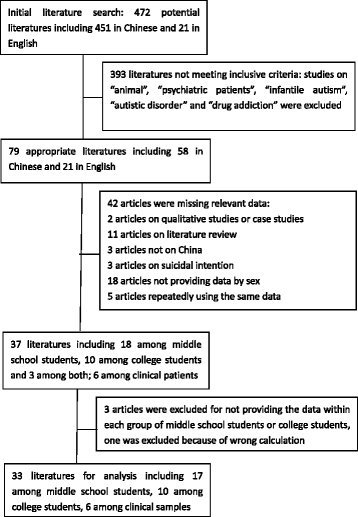A reversed gender pattern? A meta-analysis of gender differences in the prevalence of non-suicidal self-injurious behaviour among Chinese adolescents
- PMID: 28754108
- PMCID: PMC5534103
- DOI: 10.1186/s12889-017-4614-z
A reversed gender pattern? A meta-analysis of gender differences in the prevalence of non-suicidal self-injurious behaviour among Chinese adolescents
Erratum in
-
Erratum to: BMC Public Health, Vol. 18.BMC Public Health. 2017 Sep 22;17(1):736. doi: 10.1186/s12889-017-4709-6. BMC Public Health. 2017. PMID: 28938882 Free PMC article. No abstract available.
Abstract
Background: A reversed gender pattern has been observed in the suicide rate in China compared to elsewhere. Like suicidal behaviour, non-suicidal self-injurious (NSSI) behaviour is a health-risk behaviour. We examined whether a reversed gender pattern existed in the prevalence of NSSI.
Methods: Online literature databases were searched for English and Chinese articles on NSSI behaviours among the Chinese. A meta-analysis with a random-effects model and a subgroup analysis were used to estimate the odds ratios of gender differences in NSSI prevalence among Chinese adolescents including college students, middle school students, and clinical samples, as well as rural, urban, and Hong Kong middle school students.
Results: There was a male bias in NSSI prevalence among college students (OR = 1.56, 95% CI = [1.30, 1.87], p < 0.001), and a female bias among middle school students (OR = 0.83, 95% CI = [0.73, 0.94], p < 0.01), but there was no gender difference among clinical samples (OR = 0.88, 95% CI = [0.41, 1.89], p > 0.1). The NSSI prevalence among middle school students had a female bias in the rural (OR = 0.58, 95% CI = [0.47, 0.72], p < 0.001) and Hong Kong areas (OR = 0.91, 95% CI = [0.86, 0.96], p < 0.001), with the gender difference in NSSI prevalence in the Hong Kong areas being greater than in rural areas. No gender difference in NSSI prevalence was found in urban areas (OR = 1.01, 95% CI = [0.84, 1.22], p > 0.1) among middle school students.
Conclusions: Our analysis indicated the existence of specific gender and age patterns in NSSI prevalence among Chinese adolescents. The sample type, age, and the areas that have different gender norms and culture could partly explain this pattern.
Keywords: Chinese adolescents; Clinical samples; College students; Middle school students; NSSI prevalence; Reversed gender pattern.
Conflict of interest statement
Ethics approval and consent to participate
Not applicable because this is a meta-analysis study.
Consent for publication
Not applicable because this is a meta-analysis study.
Competing interests
The authors declare that they have no competing interests.
Publisher’s Note
Springer Nature remains neutral with regard to jurisdictional claims in published maps and institutional affiliations.
Figures
References
-
- World Health Organization. Suicide rates Data by country. 2012. http://apps.who.int/gho/data/node.main.MHSUICIDE?lang=en. Retrieved 18 August, 2015.
-
- Zhang J. The gender ratio of Chinese suicide rates: an explanation in Confucianism. Sex Roles. 2013;70(3–4):146–154.
-
- Nock MK. Non-suicidal self-injury: origins, assessment, and treatment. J Trauma Dissociation. 2009;12(1):105–106.
Publication types
MeSH terms
LinkOut - more resources
Full Text Sources
Other Literature Sources
Medical


